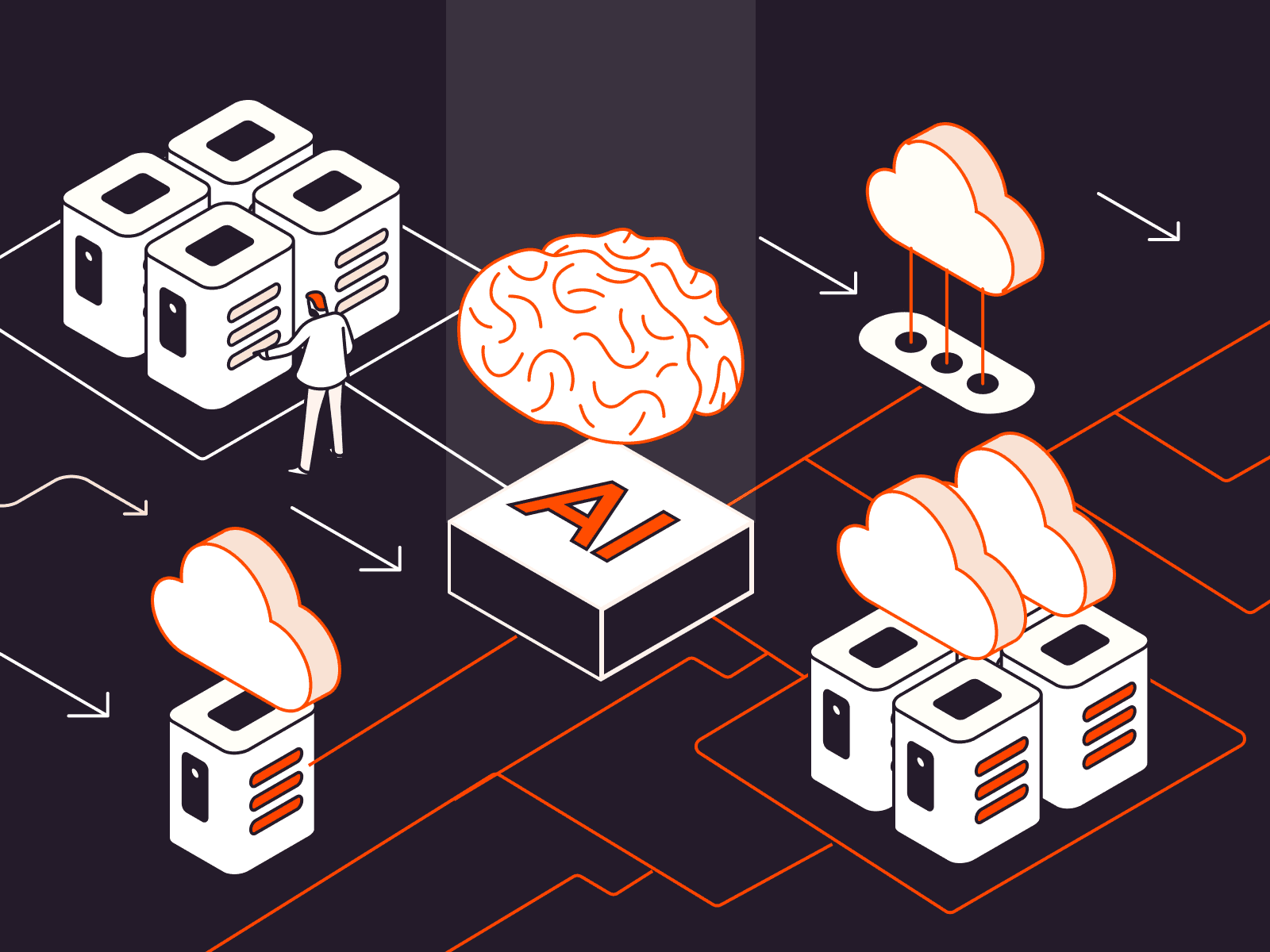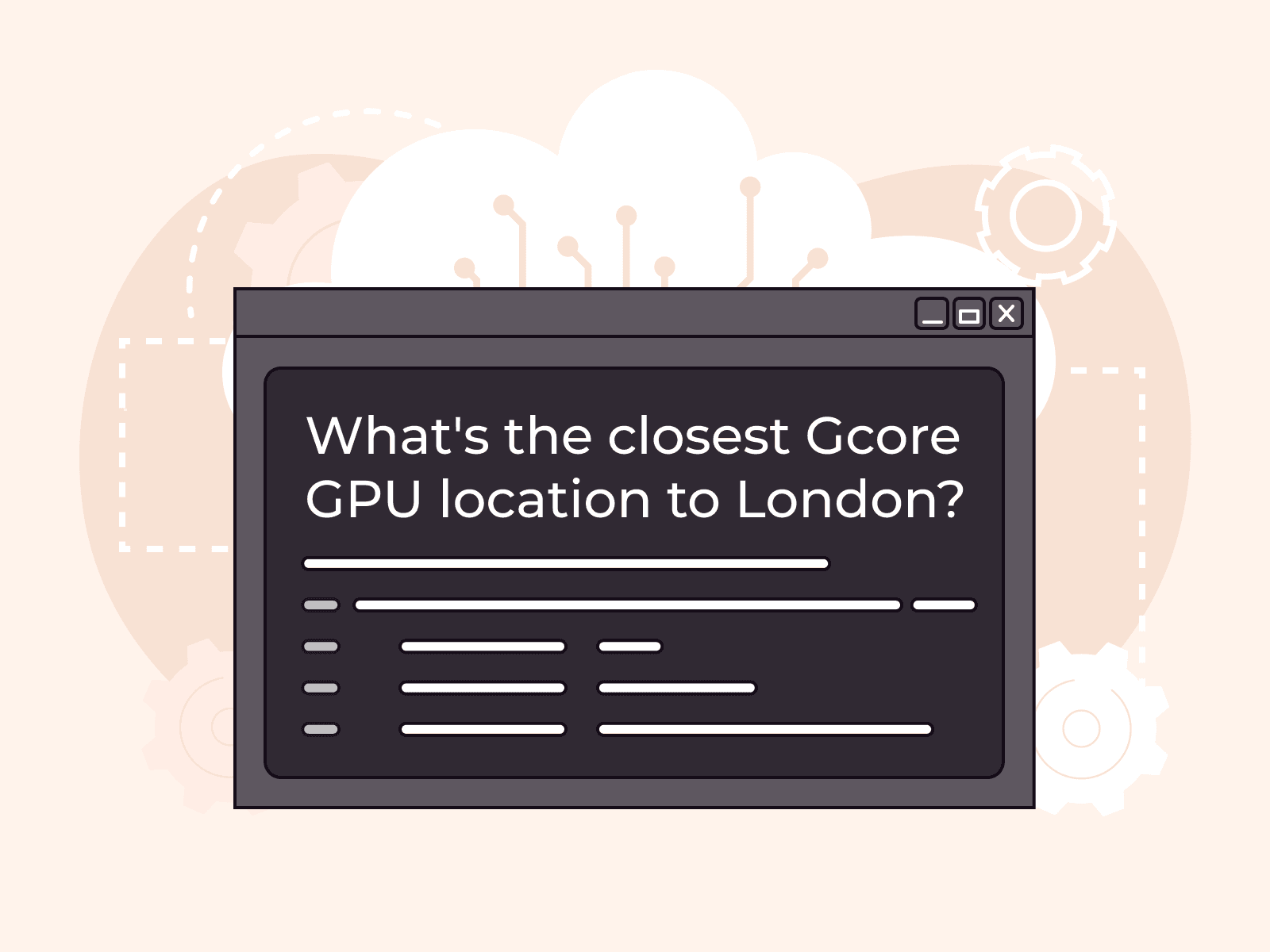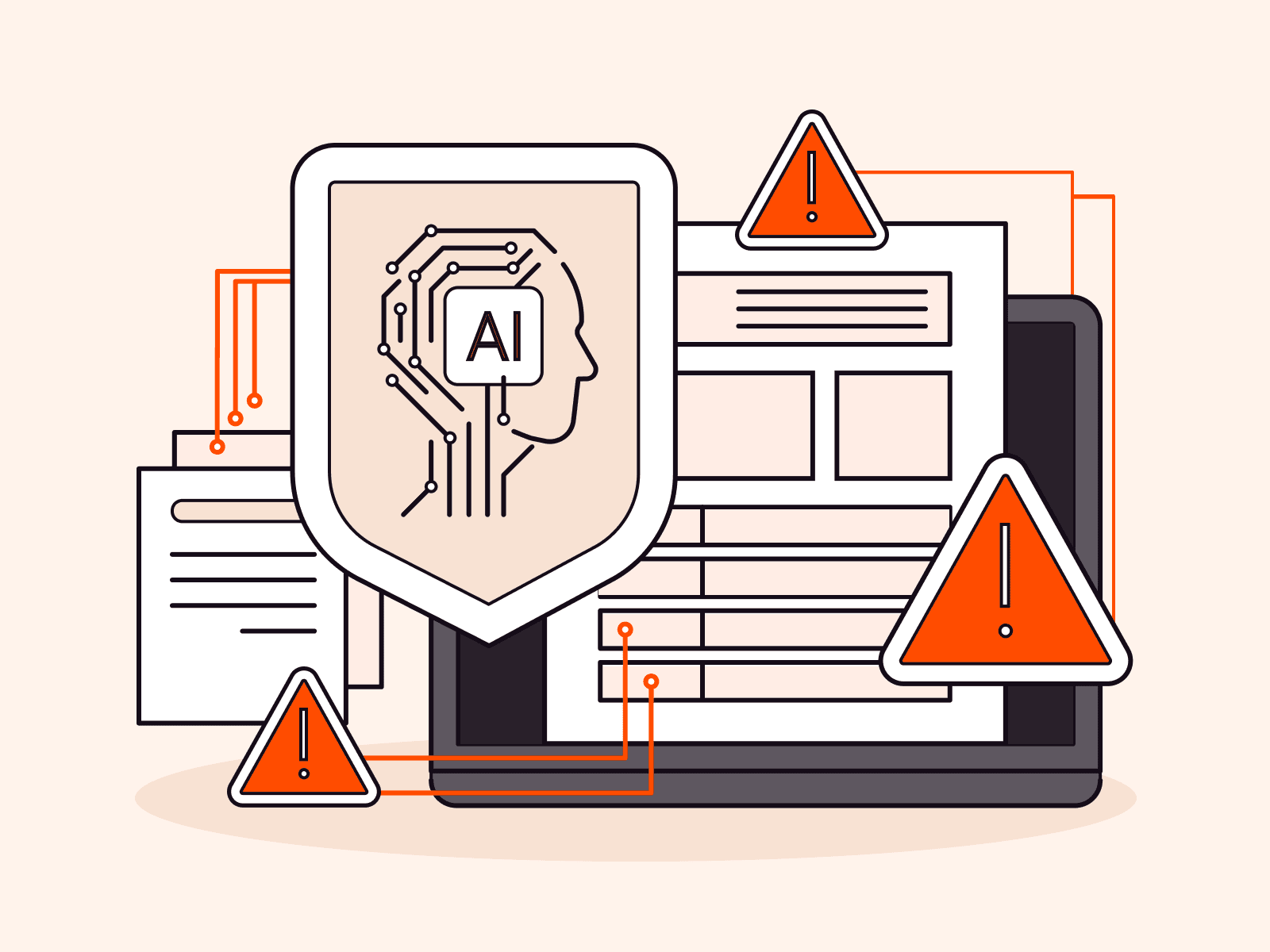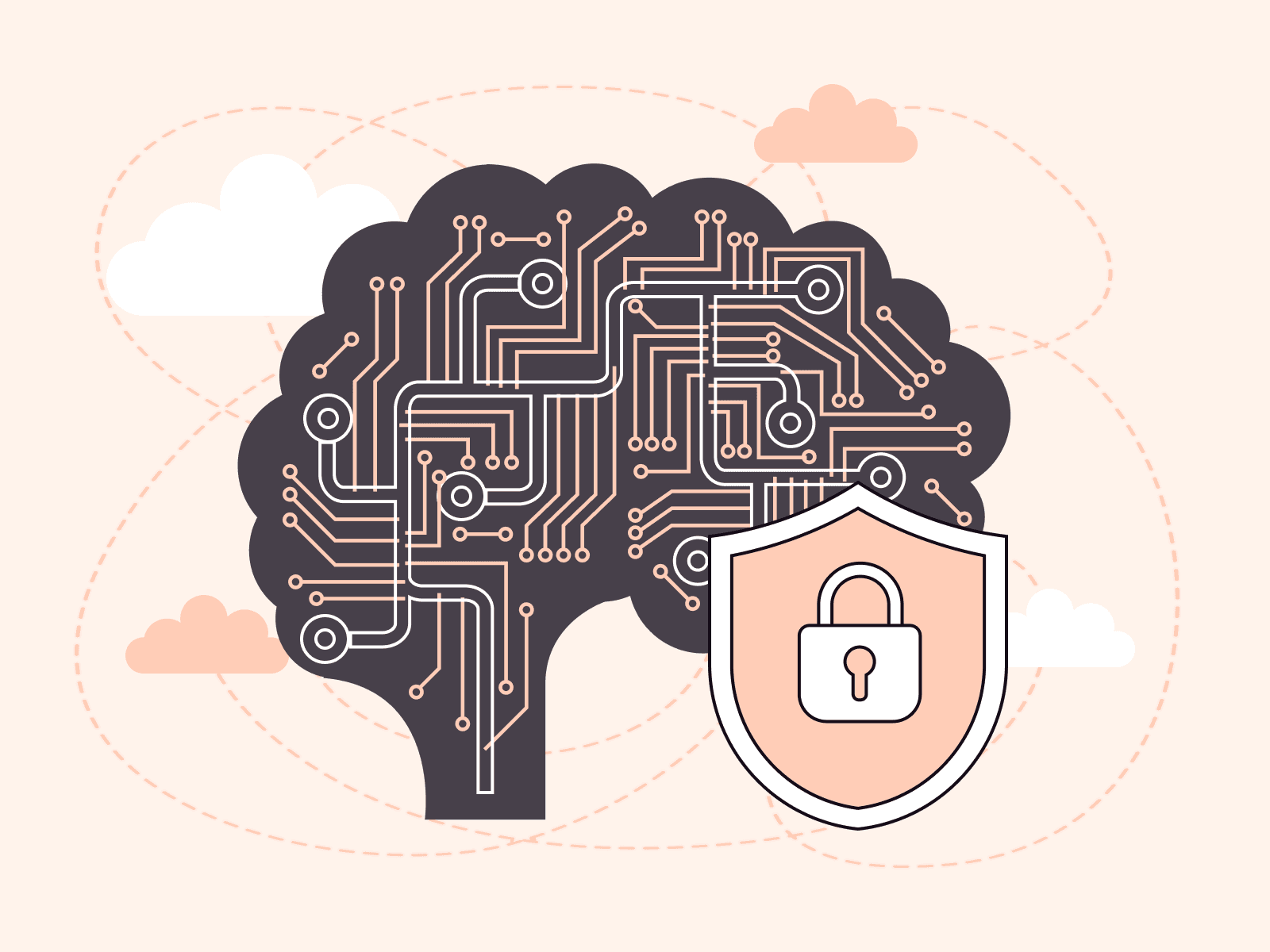The Development of AI Infrastructure: Transitioning from On-Site to the Cloud and Edge
- By Gcore
- April 26, 2024
- 8 min read

AI infrastructure—a backbone of modern technology—has undergone a significant transformation. Originally rooted in traditional on-premises setups, it has evolved toward more dynamic, cloud-based, and edge computing solutions. In this article, we’ll take a look at the driving forces behind this shift, the impact it’s having on businesses big and small, and the emerging trends shaping the future of AI infrastructure.
How Has AI Infrastructure Evolved?

The rapid evolution of technology and the subsequent shift of AI infrastructure from on-premises to cloud, and then to edge computing, represents a fundamental change in the way we process, store, and access data. Let’s look at the history of AI infrastructure to show how this evolution took shape.
AI infrastructure was traditionally based on-premises, meaning that all the servers, storage, and networking supporting AI applications were located within the physical premises of an organization. To accomplish this goal, companies housed servers on which applications were directly installed and managed.
In 1997, cloud computing was first defined. It laid the foundation for what would become cloud AI infrastructure, allowing businesses to take advantage of powerful AI capabilities without making a substantial initial investment in physical hardware. Instead, cloud AI infrastructure is designed to support AI applications by providing them with the vast computational power and data management capabilities they require to function effectively in a centralized, internet-accessible environment.
Cloud AI infrastructure includes several essential components. Distributed processing, which involves dividing large datasets into smaller segments to be processed concurrently across multiple machines, can significantly enhance AI training speeds and computing power. However, this method demands robust network speeds and meticulous coordination to be effective. Despite these challenges, when successfully implemented, distributed processing far surpasses the capabilities of traditional single-server systems in handling complex computations.
Machine learning services streamline the development and deployment of AI models by providing tools that automate tasks like model training and inference. For example, instead of manually coding algorithms, developers can use these services to select pre-built models that meet their needs. APIs (application programming interfaces) and SDKs (software development kits) further simplify the integration process, allowing developers to easily enhance their applications with AI features. This means adding complex capabilities, such as image recognition or natural language processing, without the need to write extensive new code.
The compute infrastructure within the cloud can efficiently perform complex AI tasks, such as processing large datasets and running sophisticated algorithms. Additionally, monitoring and management tools are equipped with features like real-time analytics and automated alerts that help ensure AI systems function optimally. These tools can adjust system parameters automatically based on performance data, such as increasing computing power during high-demand periods or optimizing resource allocation to improve efficiency.
More recently, in 2020, the focus shifted to edge AI. This model shifts AI-driven inference processes to the point of need, whether on a local device or a nearby computer, thus reducing latency by avoiding the need to send data back and forth to distant servers or cloud systems. Training of AI models can occur centrally, as it does not impact the end-user experience with latency.
Regarding storage, while training datasets can be centralized, databases for retrieval-augmented generation (RAG) models, which interact dynamically with operational models, should be at the edge to optimize response times and performance.
How the Evolution of AI Infrastructure Impacts the Tech Stack
The choice of AI infrastructure—whether on-premises, cloud, or edge—can profoundly impact the various layers of an organization’s tech stack; the set of technologies, software, and tools used to develop and deploy applications, as well as the regulatory requirements that are designed to protect the data being handled.
A tech stack is essentially the building blocks of any software project, including AI. In the case of AI, it consists of three main layers:
- Applications layer: This layer is the interface where users interact with the software. It typically includes user-facing applications built on open-source AI frameworks, which are customizable to meet specific business needs and can also include general user-facing applications not directly linked to AI but enhanced by it.
Your choice of AI infrastructure affects the applications layer in the following ways:
- On-premises: Integration with other services can be complex and may demand custom solutions that slow down innovation.
- Cloud: Cloud-based AI simplifies application deployment with pre-built integrations and APIs, allowing you to connect your AI seamlessly with existing systems. This streamlines development and makes it easier to incorporate new features or data sources.
- Edge: Edge AI might limit the complexity of user-facing applications due to the lower processing power of edge devices. However, it can enhance applications requiring real-time data processing, like traffic management systems.
- Model layer: At this level, AI models are developed, trained, and deployed. It consists of checkpoints that power AI products, requiring a hosting solution for deployment. This layer is influenced by the type of AI used, whether general, specific, or hyperlocal, each offering a different level of precision and relevance.
Your choice of AI infrastructure impacts the model layer as follows:
- On-premises: Training complex models often requires significant investment in hardware, which cannot adjust flexibly to varying performance needs. If not fully utilized, this equipment incurs costs without adding value, and quickly changing or upgrading underperforming hardware can be challenging. This rigidity poses substantial risks, particularly for startups needing operational flexibility.
- Cloud: Cloud platforms offer easy access to vast computing resources for training even the most intricate models—ideal for startups. Additionally, cloud-based deployment allows for automatic updates across all instances, improving efficiency, while offering flexible offerings and pricing models.
- Edge: Limited processing power on edge devices might restrict the type of models you can train. However, edge AI excels in scenarios requiring low latency, like real-time anomaly detection in industrial equipment.
- Infrastructure layer: This layer consists of the physical and software components that provide the foundation for the development, deployment, and management of AI projects. This includes APIs, data storage and management systems, machine learning frameworks and operating systems. It is this layer that supplies the necessary resources to the applications and model layers.
Naturally, the AI infrastructure you choose directly affects the infrastructure layer itself as well:
- On-premises: Managing all hardware and software components in-house, including data storage and security systems, requires a dedicated IT team and involves managing the entire hardware lifecycle—from procuring spare parts and updating firmware to transitioning to new models and recycling old hardware.
- Cloud: Cloud providers handle the underlying infrastructure, freeing you to focus on core AI development. Cloud services offer built-in security features and readily available machine learning frameworks, reducing the need for in-house expertise.
- Edge: Managing a network of edge devices can be complex, requiring specific procedures for software updates and security patching, unlike centrally managed cloud solutions. However, edge AI can reduce the burden on your core infrastructure by processing data locally, minimizing data transfer needs.

On-Premises vs. Cloud vs. Edge AI
Now that you understand how AI infrastructure has evolved and its role within the tech stack, let’s compare the three infrastructure types to determine which might be the best fit for your organization.
| Infrastructure type | On-premises | Cloud | Edge |
| Definition | AI computing infrastructure located within the physical premises of the organization | AI services and resources offered on-demand via the internet from a cloud service provider’s data centers | Distributed computing that brings AI data collection, analysis, training, inference, and storage closer to the location where it is needed |
| Key components | Servers, storage systems, networking hardware | Virtual servers, scalable storage, networking technology | Edge servers, IoT devices, local networks |
| Advantages | Provides businesses with greater control over their infrastructure and data management, allowing for tailored security measures and compliance with specific industry standards. Enhances security and data sovereignty by keeping sensitive data within the company’s local servers, adhering to local privacy laws and regulations while reducing the risk of data breaches. | Allows for scalability, easily adjusting resources to meet fluctuating demands. Also offers flexibility, enabling users to customize solutions and scale services to fit their specific needs without developing code themselves, while significantly reducing upfront capital expenditure by eliminating the need for costly hardware investments. | Reduces the time it takes for data to be processed by analyzing it directly on the device, making it ideal for time-sensitive applications, such as autonomous vehicles or live video streaming. Also enhances data security and privacy by minimizing data transmission to the cloud, reducing exposure to potential cyber threats. |
| Limitations | Involves higher upfront costs due to the need for purchasing and maintaining hardware and software. Requires a dedicated IT team for regular updates and troubleshooting. Moreover, expanding capacity requires additional investments in physical infrastructure, which can be time-consuming and costly, inhibiting scalability. | Can introduce potential latency issues, especially when data centers are geographically distant. Also incurs ongoing operational costs, which can accumulate over time. Additionally, hosting data on external servers raises security concerns, including data breaches and privacy issues, requiring robust security measures to mitigate risks. | Due to the limited computational power of edge devices, only certain tasks can be performed, restricting the complexity of applications. The diversity of hardware and compatibility issues with deep learning frameworks may also complicate the development and deployment of edge AI solutions. Unlike cloud computing, which allows for universal updates via the internet, edge computing may require bespoke updating procedures for each device. |
| Impact on applications layer | Requires manual installation and management; complete control but complicates scaling and integration. | Enables flexible deployment and scalability; simplifies integration with APIs and services | Enhances real-time data processing; reduces bandwidth but may limit complexity due to device constraints |
| Impact on model layer | Significant hardware investment needed for model training; low latency for specific applications without internet dependency | Easy access to vast computing resources for training complex models; potential latency issues based on data center proximity | Low-latency processing that’s ideal for real-time applications; computational power limits the complexity of trainable models |
Benefits of Cloud and Edge AI
The shift towards cloud and edge AI is benefiting businesses across sectors in several ways:
- Improved scalability: As the AI needs of a business grow, these infrastructures can easily adjust to meet scalability demands. This is particularly beneficial for industries with fluctuating needs, such as retail. During busy shopping periods, cloud and edge AI can rapidly scale to manage the increased demand, ensuring a smooth customer experience.
- Cost-effectiveness: The ability to scale resources up or down as needed with cloud and edge AI ensures that businesses only pay for what they use, such as in the manufacturing sector, where edge AI is being used for predictive maintenance. Sensors detect potential equipment failures before they occur, preventing costly downtime and repairs.
- Real-time data processing: In the healthcare sector, wearable health monitors can use edge AI to evaluate real-time metrics such as heart rate and blood pressure. This could allow immediate action in emergency situations, potentially saving lives. That said, healthcare organizations using edge AI need to conduct thorough risk assessments and ensure their implementation adheres to HIPAA regulations.
- Enhanced performance: Cloud and edge AI provide quick, efficient data processing, though edge is faster than cloud, achieving a latency of 25 milliseconds or better, in some locations. This enables organizations to make data-driven decisions faster, as in the case of self-driving cars. Edge AI facilitates the processing of real-time road activities, from recognizing traffic signs to detecting pedestrians, ensuring a smoother and safer driving experience.
- Data privacy: Edge AI processes data near the source through a dedicated network, enhancing data privacy for applications that do not reside on end-user devices. This setup allows residents to manage smart-home devices like doorbells, HVAC units, and lighting systems with reduced data exposure, as less personal information is transmitted to centralized servers, thus safeguarding against potential data breaches.
When To Choose On-Premises AI
While we’ve highlighted the significant advantages of cloud and edge AI, it’s important to recognize that on-premises solutions might sometimes be the preferable choice for certain organizations. For instance, those developing autonomous vehicles may opt to keep their hazard detection capabilities on-premises to ensure the security of proprietary data.
As such, if you’re in the market for AI infrastructure, ask yourself these critical questions before choosing your infrastructure type:
- Is your business dealing with sensitive data that needs extra layers of security?
- Are there industry-specific regulations requiring you to process and store data in-house?
- Or perhaps, do you operate in areas with unstable internet and need your AI operations to run smoothly regardless?
If any of these questions apply to your organization, an on-premises AI solution could be your best bet. Such a solution offers greater control over your system, ensuring your operations are secure, compliant, and uninterrupted.
What Does the Future of AI Infrastructure Look Like?
Looking ahead, we can expect AI infrastructure that aims to resolve privacy, latency, and computational challenges, starting by increasing the number of parameters in large, general-purpose AI models. This approach aims to broaden the models’ capabilities, allowing them to tackle a wide array of tasks. We’re also seeing a trend towards creating smaller, more specialized models. These leaner models are designed to perform specific tasks with greater precision, speed, and efficiency, requiring fewer resources than their larger counterparts.
Increased Adoption of Hybrid Models
We’re moving toward a more integrated approach that combines the strengths of on-premises, cloud, and edge. Businesses could store sensitive data securely on-premises, use vast cloud computational power for heavy-duty processing, and leverage the edge for real-time, low-latency tasks. The beauty of this model lies in its flexibility and efficiency, ensuring businesses can tailor their AI infrastructure to their needs while optimizing costs and performance.
Advances in Edge Computing
Edge computing is set to become even more powerful and accessible. The aim is to equip even the smallest devices with significant processing and inferencing capabilities, reducing reliance on central servers and making real-time AI applications more feasible across the board. This trend indicates a future where AI is accessible to all, making technology more responsive and personal.
AI-Optimized Hardware
The demand for AI-optimized hardware is growing. Future AI infrastructure will likely include specialized processors and chips designed specifically to handle AI workloads more efficiently, including micro AI. These advancements could provide the necessary speed and power to support complex AI algorithms, enhancing the capabilities of both cloud and edge computing solutions.
Conclusion
As AI keeps advancing, the choice of the right infrastructure—on-premises, cloud, or edge AI—becomes key to enhancing the scalability, efficiency, and flexibility of AI applications. Thoroughly evaluating your business’s unique requirements and anticipated future technological advancements can empower well-informed decisions that optimize your AI capabilities and support your long-term goals.
If you’re interested in pushing your AI projects to the next level, Gcore’s AI Infrastructure might just be what you need. Designed specifically for AI and compute-intensive workloads, our solution uses GPUs, with their thousands of cores, to speed up AI training and handle the high demands of deep learning models.
Related articles
Subscribe to our newsletter
Get the latest industry trends, exclusive insights, and Gcore updates delivered straight to your inbox.





